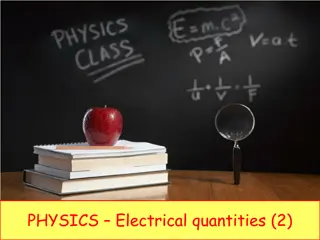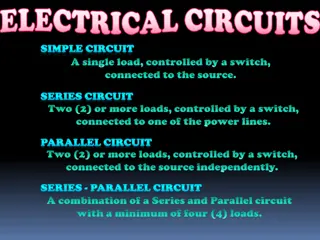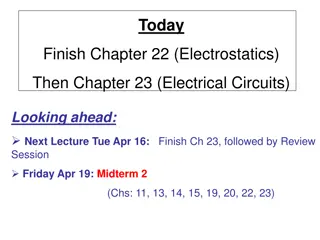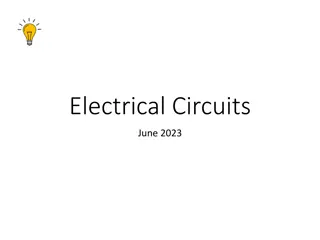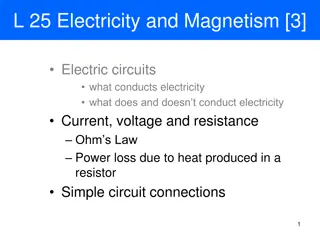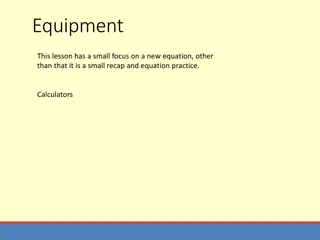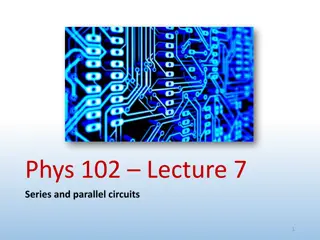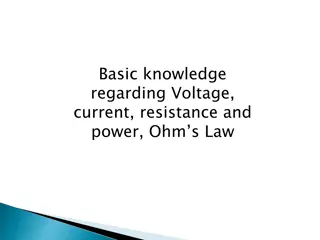Exploring Circuits and Electrical Current: Essential Concepts and Experiments
Dive into the world of circuits and electrical current with a focus on understanding the requirements, components, and functioning of circuits. Explore essential questions, experiment with building circuits, and grasp the basics of how electricity flows through a circuit. Discover the different types of circuits and their design variations to deepen your knowledge in this foundational aspect of electrical engineering.
Download Presentation

Please find below an Image/Link to download the presentation.
The content on the website is provided AS IS for your information and personal use only. It may not be sold, licensed, or shared on other websites without obtaining consent from the author. Download presentation by click this link. If you encounter any issues during the download, it is possible that the publisher has removed the file from their server.
E N D
Presentation Transcript
Circuits and Electrical Current
Essential Questions for Circuits What are the requirements of a circuit? What is actually going on in a working circuit? What variable(s) affect what other variable(s) in a circuit? What law(s) and formulas govern the relationship(s) between these variables? What are the different kinds of circuits? How do they differ (design and use)?
How do you make a circuit? You will be given one bulb, one battery and more than enough wires. Construct a sketch of how wires can be connected to light a bulb. Test your design. If it doesn t work, try variations. Record your working design(s) Summarize the requirements of a functioning circuit.
What is really happening in the circuit? Go onto Phet, Circuit Construction Kit (DC Only) Build a circuit with one bulb, one battery, one switch, and just as many wires as you need to make the circuit show you clearly what is happening when the switch is closed. What do the moving balls represent? Which way do they move?
What is really happening in the circuit? The balls represent electrons obviously NOT shown to scale. The electrons move from negative on the battery, around to positive. Before scientists knew what moved, they defined current as flowing from (the) positive (terminal) to (the) negative (terminal).
A Useful Analogy Sometimes, a closed conducting loop (circuit) is compared to a water (amusement) park. Complete this analogy: Water Park pump Circuit electrons pipes bulb
A Useful Analogy Sometimes, a closed conducting loop (circuit) is compared to a water (amusement) park. Complete this analogy: Water Park pump water pipes slide/obstacles Circuit battery electrons wires bulb
Practice Answer CYU #1,2 on PCR Lesson 2b.
Electric Potential Difference What is it? What are its units? How do we measure it? Is it the cause or the effect in a circuit? Read 1b,c Start your word web
Electric Potential Difference Slang: VOLTAGE SI unit: volt (V) named after Alessandro Giuseppe Antonio Anastasio Volta Measured with a voltmeter Analogous to difference in height, if you want to relate to gravity, or pressure in water pump By CONVENTION, the positive side of a battery is higher potential.
Electric Current What is it? What are its units? How do we measure it? What variables affect how much current exists in an appliance? Read 2c Start your word web
Electric Current The flow rate of charges Unit: ampere (amps, or just A) 1 ampere = 1coulomb of charge flowing thru a conductor in 1 second Measured with an ammeter By convention, the current flows from positive around to negative.
What Variable Affects what other Variable(s) in a Circuit? What is the mathematical relationship between the ______________(_____) through a bulb and the ______________(___) across the bulb in an electrical circuit?
What is the mathematical relationship between the current(amps) thru one bulb and the potential difference(volts) across the bulb? What is the mathematical relationship between the current(amps) thru two bulbs and the potential difference(volts) across BOTH bulbs?
Understanding the Lab What happened when potential difference was doubled? How did the results differ when a second bulb was in the loop? What do the bulbs do to the current? (more bulbs in series means ____ current)
Ohms Law: I = V/R The current in a circuit element (like a bulb) is directly proportional to the potential difference across the element, and inversely proportional to the resistance of the element
R: Resistance R = V / I R = L/A ( =resistivity, L=length, A=cross sectional area) Note: Important in AP E&M SI unit: ohm ( ) Measured with an ohmmeter All real conductors have a little of this, insulators have a LOT of it. An ideal conductor has 0 and an ideal insulator has
Resistance What is it? (use The Lazy Mile at the water park) What happens in the circuit as the resistance changes?
Example Problem Ex: A single loop circuit is made with a 1.5 volt battery, and a light bulb. An ammeter is used to measure a 0.15A current in the loop. What is the resistance of the bulb in this circuit? PCR Current Electricity 3c CYU 1-5, 7,8
(AP only) Checkpoint 3, plus also rank them greatest to least according to: - current density - drift velocity - electric field (strength) in the conductor
Lab, Part II Now, do the lab again, this time with a real bulb, using real wires, and a battery eliminator. Only go up to 6.0V What is different when you graph your data? Why do you think it is different? What happened to the brightness of the bulb as you increased the potential difference through it? What MEASUREMENT relates most closely to brightness in the bulbs?
What measurement looks at How much charge flows thru a wire in a second? How the wire prevents the charges to flow? The difference in energy (carried by each charge) between two positions in a circuit? The rate at which energy is transferred (or WORK is done)?
Energy is The ability to do work Measured in joules Also measured in calories (1 cal = 4.18J) Also measured in kilowatt x hours (1kWhr = 3.6x106J) Something we will define more completely in the last unit of the course
Power The rate at which work is done / energy is changed or transferred Measured in watts (1watt = 1joule / 1 second) Also measured in horsepower (1hp = 746W) Also measured in kW (1kW = 1x103W)
Measurements in a circuit I: Current (in amperes (A)) V: Potential difference (in volts (V)) R: Resistance (in ohms ( )) Power (in watts (W))
Equations I= V/R V = IR R = V/I P = I( V) P=I2R P = ( V)2/R
Series Circuits All elements in a series circuit (or branch) have the same__________________ If you add up the ________________in the elements that are in a series circuit, the result is equal to the _________________of the battery. The power supplied by the battery equals the sum of the power dissipated by all resistors. In Series, Req= ?
Series Circuits All elements in a series circuit (or branch) have the same current If you add up the potential differences in the elements that are in a series circuit, the result is equal to the potential difference of the battery. The power supplied by the battery equals the sum of the power dissipated by all resistors. In Series, Req= R1+ R2+ +Rn
Example Draw a series circuit with a 3.0V battery, a 6 light bulb, and a 3 light bulb. Determine the equivalent resistance of the circuit, the current through each item in the circuit, the potential difference across each item in the circuit, the power supplied by the battery, and the power used by each of the bulbs.
Series Circuits Charge is neither created nor destroyed, so the __________ is the same for all parts of the circuit. Energy is neither created nor destroyed, so the sum of the ______________ for all the bulbs must equal the same measurement for the battery.
Parallel Circuits All elements in a parallel circuit have the same potential difference If you add up the current in all the elements that are in parallel, the result is equal to the current through the battery. The power supplied by the battery equals the power dissipated by the resistors in total In Parallel, 1/Req= 1/R1+ 1/R2+ +1/Rn
Parallel Circuit Draw a circuit with a 3.0V battery, a 6 light bulb, and a 3 light bulb connected in parallel. Determine the equivalent resistance of the circuit, the current through each item in the circuit (that is three different measurements), the potential difference across each item in the circuit, the power supplied by the battery, and the power used by each of the bulbs.
Parallel Circuits Charge is neither created nor destroyed, so the sum of the __________ for all the bulbs is the same as this measurement for the battery. Energy is neither created nor destroyed, so the sum of the ______________ for all the bulbs must equal the same measurement for the battery. Each bulb has the same _________ as the battery, because the wires connect each bulb to the battery without any resistance (actually, with negligible resistance).
Practice Problem A 1.0 and a 2.0 light bulb are wired in parallel, then connected to a 6.0V battery. Determine the power supplied by the battery, and dissipated by each bulb. Which is brightest? Now, the bulbs are wired in series to the same battery. Determine the power supplied by the battery, and dissipated by each bulb. Which is brightest?
Is Physics Real? Objective: Determine if the statements made about electric potential difference on slides 35 & 39 are true in actual circuits. If measurements do not show these statements are 100% accurate, why not? Are the statements false, or is something else (another measurement) affecting the investigation.
Validating One Rule of Parallel and Series Circuits Reports: - Objectives - Circuit Diagram, labeled - Data shown neatly - Each statement, followed by the measurement(s) and brief description(s) that support, or refute the claim. If the claim is not (well) supported, explain why you still believe it is true.
Now, we look at the other, relevant measurement in electrical circuits
What does the 60 watts mean for a bulb? A) The bulb has 60 W and after that, it is used up B) When turned on, the bulb uses 60 watts regardless of the circuit it is in C) If the bulb is across a potential difference of 120V, the bulb dissipates 60 J of energy each second.
60W vs 120W Determine the resistance of a 60W bulb and of a 120W bulb. Which draws more current? What is the cost of running each for 2 hours?
What is a KILOWATT-HOUR? A) a unit of power B) a unit of electricity C) a unit of energy D) a unit of work E) a unit of current F) a unit of potential difference G) the amount of heat needed to warm 1.0 ml of water by one degree Celsius
A kWhr is. (1000W) x (1hr) (1000J/s) x (3600s) 3 600 000J 3.6 x 106 J 3.6 MJ The amount of electrical energy your parents pay about $0.20 for
Energy SI unit: joule (J) Other units: calorie, kilocalorie, kilowatt-hour E = P * t (because a J/s * s = J) This is the physics measurement most closely analogous to $$$ (1.0kWhr or 3.6 million joules - of electrical energy costs about $0.25)



